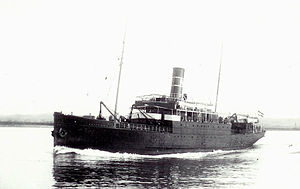 SS Batavier V
| |
| History | |
|---|---|
| Name | SS Batavier V |
| Owner | William Müller & Co.[1] |
| Operator | Batavier Line[1] |
| Port of registry | |
| Route | Rotterdam–London[1] |
| Builder | Gourlay Brothers, Dundee, Scotland[2] |
| Yard number | 205[2] |
| Launched | 28 November 1902[3] |
| Completed | February 1903[2] |
| Captured | seized as prize by U-28, 18 March 1915, but later released[4] |
| Fate | mined and sunk, 16 May 1916[4] |
| General characteristics | |
| Type | steam packet |
| Tonnage | 1,562 GRT[2] |
| Length | 79.3 m (260 ft 2 in) (lpp)[2] |
| Beam | 10.7 m (35 ft 1 in)[2] |
| Propulsion | 1 × 3-cylinder, triple-expansion steam engine, 2,300 ihp (1,700 kW)[1] |
| Speed | 14.5 knots (26.9 km/h)[2] |
| Capacity |
|
SS Batavier V was a steam packet for the Batavier Line that sailed between Rotterdam and London for most of her career. The ship was built in 1897 by the Gourlay Brothers of Dundee. The Dutch ship could carry a limited amount of freight and up to 428 passengers. She was rebuilt in 1909 which increased her length by over 5 metres (16 ft).
During World War I, the Batavier Line attempted to maintain service, but in March 1915, Batavier V was seized as a prize by German submarine U-28 and sailed into Zeebrugge in German-occupied Belgium. The ship was released by a German prize court in September. In May 1916, Batavier V struck a mine laid by German submarine UC-6 off the British coast and sank with the loss of four lives.
- ^ a b c d e "Batavier Line". Simplon Postcards: The Passenger Ship Website. Ian Boyle. Retrieved 18 March 2009.
- ^ a b c d e f g h "Batavier V (5600938)". Miramar Ship Index. Retrieved 18 March 2009.
- ^ "Gale at Dundee. A Launch in the Storm". Dundee Evening Post. Dundee. 28 November 1902. Retrieved 11 November 2015 – via British Newspaper Archive.
- ^ a b Helgason, Guðmundur. "Ships hit during WWI: Batavier V (p.)". German and Austrian U-boats of World War I - Kaiserliche Marine - Uboat.net. Retrieved 18 March 2009.